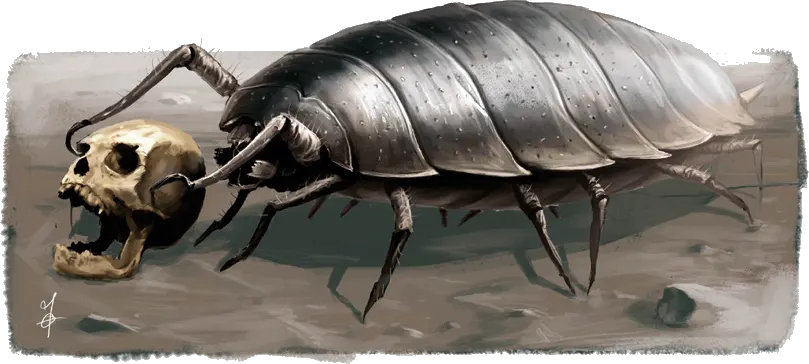“Brothersister, the world as created by Rur knows only beauty, even though some creatures may seem disgusting at first glance. Take, for instance, the crypt bug. They are large, have many legs, and devour carrion. There seems to be nothing about them that one would call beautiful. And yet, these giant crustaceans are a gift of the gods. Remember, if not for the crypt bugs, there would be a lot more rotting flesh lying around everywhere. Crypt bugs do us a great service by devouring carcasses. Thanks to them, fewer carrion feeders live around humans and we are spared many diseases. Plus, they also eat rats, the only creature I think was not a present from Rur to Gror. As long as you leave it alone, the crypt bug will leave you alone.
Yes, sometimes they attack humans, but what do you expect from wild animals? They really only attack you if you provoke them. It is quite easy to avoid them entirely. How? Don’t venture where these creatures live. That is always the best choice. And there is always a choice. I’ve never met someone who could prove they had only one option…”
— Garakziber, gardener from Zorgan, in a philosophical dispute with a Maraskani visitor, modern
Crypt louses, sometimes called crypt bugs, are scary monsters from the lightless world below. They are essentially dog-sized crustaceans. Their razor-sharp and uncommonly powerful mandibles pose a considerable threat to life and limb, their hard shell is a serious challenge for sword or axe, and even their appearance sorely tests courage and morale.
Crypt bugs have a very bad reputation, and are thought to attack any humans they perceive. The dwarves tell some colorful tales of these many-legged creatures, and their ancient legends tell of large numbers of crypt bugs that constantly prowled the home tunnels of the Angroshim, always searching for food.
Some say they servants of the dragons or other dark powers. Actually, crypt bugs prefer abandoned areas and fight two-legged beings only if when threatened or starving. They are not particularly intelligent and live mainly by their instincts.
Distribution
It is unknown whether the crypt louse is the legacy of the Seventh Age, in which many-legged beings ruled over Dere, or simply a whim of Sumu. An appearance by one of these expressionless monsters is always accompanied by eerie clicking sounds. Groups of them nest primarily in dark, damp places such as cave systems, ruins, crypts, catacombs, and canals.
These creatures seem native to all continents. One may encounter them in Myranor and Uthuria where even larger and more intelligent specimens are said to exist.
Whether this is merely a sailor’s yarn or the truth is not yet known, but giant crypt lice have already been caught by Uthuria questadores and brought to the Bal-Honak Arena in Al’Anfa to be pitted against gladiators.
Way of Life
The crypt louse is understood to be a patient hunter that waits until prey wanders too far into its preferred habitat (subderanian labyrinths), gets hopelessly lost, and finally dies. Due to their size, crypt louses do not fear humans, elves, or dwarves. And even though they are primarily carrion feeders, given advantageous terrain, they might try to expand their diet.
They normally feed on mice, rats, and insects — basically anything that is smaller than them and which they can catch. They avoid sunlight, even though it does not cause them pain, because they simply dislike it. Therefore, crypt louses are usually encountered in dark places.
Little is known about how long a crypt louse can live, as few scholars bother to study these animals. However, they definitely live longer than their smaller cousins, the pill bugs (which are also on the menu). The life expectancy of a crypt louse is estimated to be around twenty years. The brood of one louse usually consists of a dozen animals, of which only about half reach maturity. The rest fall victim to greedy siblings, hungry parents and relatives, or other predators. Unlike the tasty innards of the giant stag beetle, intelligent beings find the flesh of the crypt bug inedible, as its stench alone causes nausea.


